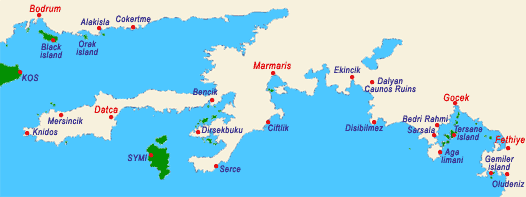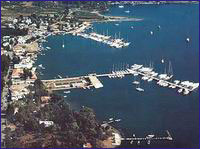 Gocek Gocek
With its geographical position, Göcek has been transformed over the past several years to become the ‘in’ spot for salty dogs and international yachtsmen, gaining a fine reputation in the process. From the latest model yachts to the smallest boats, the bays of Göcek are one of the few places on earth that mariners can cruise throughout the year. In addition, Göcek is an ideal spot from the standpoint of wind, sea and air temperature, whereas it is located only 22 km. away from Dalaman International Airport. Moreover, its yacht harbor, which was constructed in recent years and is still undergoing expansion. has become a place of distinction. For instance, you can board a plane in Istanbul, or Ankara or from even outside the country and within a couple of hours, you’ll be whisked away from all your outside world worries to embrace Göcek, where the blue sea laps against green forests to form the magical hue of turquoise.
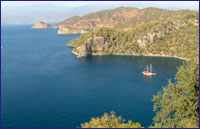 Gulf of Fethiye Gulf of Fethiye
In sailing E from the direction of Marmaris, you will round Kurtoglu Burnu to enter the Gulf of Fethiye, which is one of the most beautiful gulfs in the world. Situated between Kurtoglu Burnu and Iblis Burnu are 12 islands of various sizes and several magnificent bays in this gulf which is swathed in forests. You will never get enough of these bays and they are going to ensure that you have a very delightful time here.
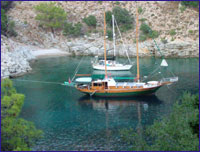 Aga Limani Aga Limani
When we enter the Fethiye Gulf our next stop will be Aga Limani. From here with a 30-minute hike takes you to ancient Lydae. Off the beaten path and rarely visited, Lydae features sarcophagi, temple walls, cisterns, Corinthian columns and inscribed tablets from the Roman and Byzantine periods.
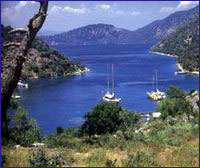
Gobun Bay
This anchorage, which is surrounded by pine woods and Olive groves, provides shelter from winds in all directions whereby up to 50 vessels can moor here concurrently. If you visit here in the summer, be prepared to put up with the maritime traffic as it is a popular spot.
There is a cozy little bay between Göbün Koyu and Yavansu Koyu, sandwiched between two mountains, called ‘Merdivenli Koyu’ by the local villagers. The small beach inside the steep rocks on either side of the bay is very impressive. The cave situated behind the beach can be reached by climbing over some high steps. It must be because of these steps that the bay was called ‘Merdivenli Koyu.’ 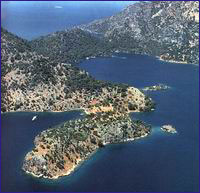 Manastir Bay Manastir Bay
There is a fabulous bay shaded by pines just one nautical mile to the W of Bozburun called Manastir Koyu. In the SE quadrant of Manastir Koyu, one can see ruins in the sea that have been named by the local folks as Cleopatra’s Hamam. However, this is a fallacy as these ruins do not date back to the time of the Egyptian Queen, but rather to that of the Byzantine Empire. The pines lean into the sea as if they are kissing it whereas they stretch from water’s edge to the top of the hills, adding distinct beauty to the bay.
The S quadrant of the bay, where there is an island as well as remnants of a Roman bath, is considered to be an ideal spot to anchor as it remains calm in stormy weather. It is a comfortably nice place to spend the night as long as there is no wind blowing. In the W part of Manastir Koyu is an old, long wall that runs by a restaurant called Wallbay. This wall was built to protect Lydae at the top of the isthmus and its village Arymaxa. From here it extends up to the hill and then back down to the sea again. Thusly, the peninsula was securely cut off from the mainland. When you get to the top of the hill the beautiful view of Gokgemile Koyu is going to amaze you. The shoals off the coast are like a motif of the panoramic view. 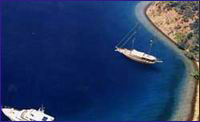 Sarsala - Sirali Buk Sarsala - Sirali Buk
Ruins of an old dwelling as well as that of an ancient pier can be seen in the water to the W of the peninsula. There is a road from land to this bay, which is comprised of two coves known as Büyük and Küçük Sarsala.
There are a number of small coves in this bay, which is exposed to the 5, whereas some vessels drop anchor in these coves. There is a mountain path behind these on which one can trek up to Erentepe and Kocagöl. Kocagöl is 2 - 3 km. beyond Sarsala. Here the ancient city of Lyssa is situated at Kizilagaç Mevkii. The only author of antiquity to have ever mention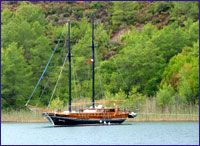 ed this city was Pliny. It is known that the city did not mint any coins but it was mentioned in inscriptions. A part of the acropolis walls remains standing, whereas there are inscriptions on the S side of the walls. These are honor inscriptions that were written in the 3rd century B.C. during the period of Ptolemiac Dynasty. Nothing much remains of the ancient city save for tombs that are seen between the city and the sea. However, as with other cities of antiquity, there most certainly should have been ruins of some private and official buildings as well. ed this city was Pliny. It is known that the city did not mint any coins but it was mentioned in inscriptions. A part of the acropolis walls remains standing, whereas there are inscriptions on the S side of the walls. These are honor inscriptions that were written in the 3rd century B.C. during the period of Ptolemiac Dynasty. Nothing much remains of the ancient city save for tombs that are seen between the city and the sea. However, as with other cities of antiquity, there most certainly should have been ruins of some private and official buildings as well. The other name of Sirali Bükü, which is located in the inlet of Martin Burnu to the N of Sarsala Pier, is Martin Koyu. The bay is surrounded by tall mountains and unites with the pine trees growing on the peaks. It is possible to moor anywhere along the cape, which has five beaches. 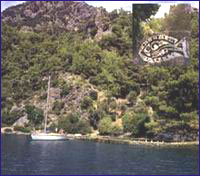 Bedri Rahmi Cove Bedri Rahmi Cove
One of the most important bays in the gulf is Bedri Rahmi Koyu, known by the local people as Taskaya. Situated opposite Tersane Adasi, this bay was named after the Turkish writer and artist Bedri Rahmi Eyüpoglu, who was one of the first to experience a ‘Blue Voyage’ back in 1973. During this pioneer journey, he painted a picture of a fish on a boulder behind the fountain here. A number of Turkish intellects and artists such as Bedri Rahmi, his brother Selahattin Eyüpoglu and Azra Erhat participated on the first ‘Blue Voyage’ and discovered all this natural beauty. In describing these incredible bays in subsequent newspaper articles and books, they recommended that everyone experience what eventually became known as the ‘Blue Voyage.’
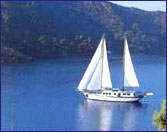 There is a freshwater fountain under some immense pine trees at the NE end of this wide bay, which poses no problems as far as entering it is concerned. You can drop anchor at a depth of 2 —2.5 m. at the spot where a restaurant and a pier are located, and replenish your water supply at the fountain at the same time. You can see Bedri Rahmi’s picture of a fish right behind this fountain and just behind it is a Lycian rock tomb seemingly lurking amongst the trees. In addition to this tomb, there are numerous Lycian pigeon-hole tombs carved into the face of a [arge rock. In addition, one can encounter a rock tomb with an embroidered gate as well as three tombs lying next to each other further on ahead. These rock tombs are peculiar to the Lycians in that they reflect examples of their wooden edifices. These rock tombs, of which we have seen several examples in Caunos, with more to be seen in Fethiye and Myra, date to the 4th-5th centuries B.C. and belong to the ancient city of Crya, located up on the hill. There is a freshwater fountain under some immense pine trees at the NE end of this wide bay, which poses no problems as far as entering it is concerned. You can drop anchor at a depth of 2 —2.5 m. at the spot where a restaurant and a pier are located, and replenish your water supply at the fountain at the same time. You can see Bedri Rahmi’s picture of a fish right behind this fountain and just behind it is a Lycian rock tomb seemingly lurking amongst the trees. In addition to this tomb, there are numerous Lycian pigeon-hole tombs carved into the face of a [arge rock. In addition, one can encounter a rock tomb with an embroidered gate as well as three tombs lying next to each other further on ahead. These rock tombs are peculiar to the Lycians in that they reflect examples of their wooden edifices. These rock tombs, of which we have seen several examples in Caunos, with more to be seen in Fethiye and Myra, date to the 4th-5th centuries B.C. and belong to the ancient city of Crya, located up on the hill.
 Tersane Island Tersane Island
The largest island in the Gulf of Fethiye is that of Tersane Adasi. One enters Tersane Koyu, which is a natural harbor stretching inland on the island’s NW side, through a deep channel measuring 100 m. across. You can anchor in anywhere in the bay except the E and NE parts, where sunken sections of piers are scattered about in the shallows. It is safer to moor on the W side as it is closed off to the prevailing lodos and yildiz winds.
We know that Tersane Adasi, which used to be known as Telandria, was inhabited during ancient times.However, there are a total of 140 dilapidated houses on land as well as submerged in the sea that catch one’s eye. These houses belonged to the island’s inhabitants who emigrated to Rhodes in 1923. 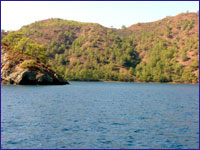 There are ruins of two churches, one adjacent to the well and the other on the hill, as well as the graves of the ancient people’s community leaders in the W. There are ruins of two churches, one adjacent to the well and the other on the hill, as well as the graves of the ancient people’s community leaders in the W.
The island derived its name from the fact that the Ottoman naval fleet used it as a shipyard during World War I. Before the population exchange, the people here were known to be involved with raising fruit orchards and animal husbandry. Again, you can still encounter fruit orchards and goat herds. 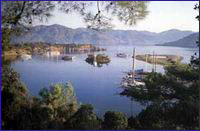 Yassica Isles Yassica Isles
The islands called Yassica Adalari which arouse interest because of their mysterious appearance and are favoured by yachts.
Ak Bükü
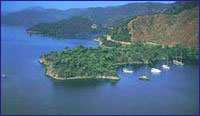 Ak Bükü, which is located N of Boynuz Bükü and W of Göcek Adasi, is comprised of two bays, one situated in the S and the other in the N. There is a large boulder situated in the entrance of the bay, whereas there is a beach and a fountain amidst the pine trees on the N shore. Several bays line the shores between here and Göcek. One of these is Günlüklü Koyu, decorated with styrax trees in the immediate vicinity. Another is Osmanaga Koyu, which is located on the other side of the peninsula which borders Gunlüklü Koyu. However, beware of the small islet S of the bay which renders passage between this islet and the shore impossible. Extending out into the sea like a tongue, Ince Burun Peninsula is situated next to Osmanaga Koyu. Ak Bükü, which is located N of Boynuz Bükü and W of Göcek Adasi, is comprised of two bays, one situated in the S and the other in the N. There is a large boulder situated in the entrance of the bay, whereas there is a beach and a fountain amidst the pine trees on the N shore. Several bays line the shores between here and Göcek. One of these is Günlüklü Koyu, decorated with styrax trees in the immediate vicinity. Another is Osmanaga Koyu, which is located on the other side of the peninsula which borders Gunlüklü Koyu. However, beware of the small islet S of the bay which renders passage between this islet and the shore impossible. Extending out into the sea like a tongue, Ince Burun Peninsula is situated next to Osmanaga Koyu. 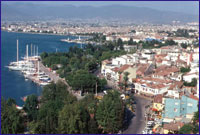 Fethiye Fethiye
Situated on the slopes of Mendos Mountain, Fethiye was established on top of ancient Telmessos on the shores of the Gulf of Fethiye. For this reason, the majority of the ruins have remained under this quaint district. Because of the abundance of accommodation facilities, captivatingly beautiful coves and significant development in yacht tourism in recent years, Fethiye represents the center of excursions in the Lycian region.
The significance of the city, which continued its existence into the Byzantine era, waned with the Arabian raids which occurred after the 7th century. The city’s name was changed to Anastasiupolis during the 8th century in honor of the Byzantine Emperor Anastasiupolis II, whereby the following century this too gave way to the Makri, which meant ‘far city.’ Later on, the city was called Megri, whereas Megri was finally changed to today’s Fethiye in 1934, to commemorate one of the first Turkish aviators, Fethi Bey. 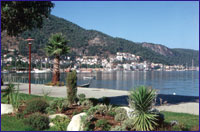 C. Texier, who saw Telmessos in the 1850’s, indicated that the Apollo Temple and theater could be seen at that time. Not long after C.Texier’s visit, a major earthquake struck in 1856, which knocked down these structures, and when Fethiye was hit with a second devastating quake just over 100 years later, in 1957, these ruins were completely destroyed. Today’s Fethiye is what was built up after this second temblor more than forty years ago. Today, the theater, which was found near the pier of new Fethiye, has been uncovered. This theater, which had the capacity to hold 5,000 people, was built in the Early Roman Period and renovated later in the 2nd century A.D. C. Texier, who saw Telmessos in the 1850’s, indicated that the Apollo Temple and theater could be seen at that time. Not long after C.Texier’s visit, a major earthquake struck in 1856, which knocked down these structures, and when Fethiye was hit with a second devastating quake just over 100 years later, in 1957, these ruins were completely destroyed. Today’s Fethiye is what was built up after this second temblor more than forty years ago. Today, the theater, which was found near the pier of new Fethiye, has been uncovered. This theater, which had the capacity to hold 5,000 people, was built in the Early Roman Period and renovated later in the 2nd century A.D.
A medieval castle situated on the acropolis hill, where the city was first established, is surrounded by a wall. Today, one can see the bottom portion of this wall, which was erected by the Romans as well as the upper part, which was constructed during the Middle Ages, when the Rhodian Knights used this castle as well as Sövalye Adasi, located in the harbor, to hold the city under their control. 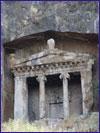 The Tomb of Amyntas, which is the most splendid and best known of all the tombs, is located on the E face of the city’s acropolis and has become the symbol of Fethiye. Seen from the plain below, it gives a great impression of size from up close. It is of the temple-type, in the Ionian order. Four steps lead up to the porch with two columns between pilasters; halfway up the left-hand pilaster the name of Amyntas, son of Hermapias is inscribed in letters of the 4th century B.C. Encountering this tomb in the 1850’s, C. Texier apparently wished to document this as he signed the upper left corner of the grave door. The Tomb of Amyntas, which is the most splendid and best known of all the tombs, is located on the E face of the city’s acropolis and has become the symbol of Fethiye. Seen from the plain below, it gives a great impression of size from up close. It is of the temple-type, in the Ionian order. Four steps lead up to the porch with two columns between pilasters; halfway up the left-hand pilaster the name of Amyntas, son of Hermapias is inscribed in letters of the 4th century B.C. Encountering this tomb in the 1850’s, C. Texier apparently wished to document this as he signed the upper left corner of the grave door.
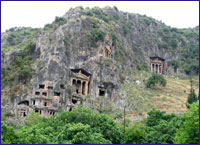 In the cliff-face further to the left are numerous other tombs; two of these are temple-tombs similar to that of Amyntas, and little less impressive. There are also a number of Lycian-type sarcophagi within the city. One of these is situated on the street directly below these stone monuments, while the other stands besides the municipal building near the pier. The sarcophagus next to the municipal building is one of the few sarcophagi with reliefs that has managed to remain intact to the present. Both sides of the lid and of the surmounting Crest carry reliefs showing rows of warriors with shields in their hands, with a man sitting in an armchair wearing long clothing on the right side. The ends of the lid are divided into four panels. This sarcophagus, which was erected in ca. 340 B.C., once had reliefs on the bottom part as well, which is understood from the drawings of both Sir Charles Fellows and C.Texier. In addition, there are two sarcophagi from the 4th Century that are located in the Cumhuriyet District, one of which has reliefs. However, these reliefs are in poor condition. In the cliff-face further to the left are numerous other tombs; two of these are temple-tombs similar to that of Amyntas, and little less impressive. There are also a number of Lycian-type sarcophagi within the city. One of these is situated on the street directly below these stone monuments, while the other stands besides the municipal building near the pier. The sarcophagus next to the municipal building is one of the few sarcophagi with reliefs that has managed to remain intact to the present. Both sides of the lid and of the surmounting Crest carry reliefs showing rows of warriors with shields in their hands, with a man sitting in an armchair wearing long clothing on the right side. The ends of the lid are divided into four panels. This sarcophagus, which was erected in ca. 340 B.C., once had reliefs on the bottom part as well, which is understood from the drawings of both Sir Charles Fellows and C.Texier. In addition, there are two sarcophagi from the 4th Century that are located in the Cumhuriyet District, one of which has reliefs. However, these reliefs are in poor condition.
 Oludeniz Oludeniz
Situated behind Yogan Burnu, Ölü Deniz is a hidden paradise which possesses intriguing beauty. The shadow of the pine trees on the opposite side look as though they being washed in the sea. Vessels have been banned from entering the world-famous Ölü Deniz since 1983. though, it is possible to drop anchor in the inner part of Yogan Burnu, One needs to look out for the rocks in front of this promontory. This tranquil beauty was also discovered by people who lived hundreds of years ago. Christians making their pilgrimage during the 12th century visited Ölü Deniz en route to their destination. In taking shelter here during stormy weather, they prayed and waited for the force of the gale to diminish. In the Medieval Ages. 11 churches for the pilgrim candidates were erected in an area called Sybola. In addition to the churches found on the islands of Karacaören and Gemiler, there is one in the back and another one in the middle part of Ölü Deniz. The church in the middle section is nestled amongst some bushes on the right side of the road leading to Ölü Deniz. The church in the back of Ölü Deniz is situated in the touristic facilities there. Excavation work carried out at one of these church sites indicates that ancient civilizations knew about Ölü Deniz.
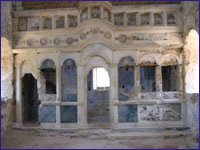 Kayakoy Kayakoy
It is a Greek settlement founded beginning from 14th century over antic Karmillassos, fully destroyed excluding a few house type tomb as a result of earthquakes and foundation period is not known definitely.Its former name is Levissi. Kayaköy, teaching humanity on the concepts of friendship, brotherhood and peace, and united with five Turkish villages during its lifetime, is one of the pride resources of our region. According to a "population exchange" agreement signed between Turkish and Greek governments on 1922, Greek population of Kayaköy is exchanged with Turkish population residing in Western Thrace.
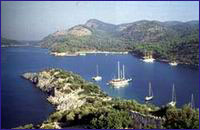 Gemiler Adasi ( St. Nicholas Island ) Gemiler Adasi ( St. Nicholas Island )
Gemiler Adasi was a town of the Middle Ages. The island, which measures 1,000 x 400 in., is separated from the mainland by a narrow channel in the position of an exquisite harbor. Although the S part of the island is very steep, the N side is very convenient for yachts and because it has a slight grade, it is also possible to get onto the island from here. The N shore was once the island’s harbor, but due to earthquakes which struck the region throughout history, the pier which served the harbor hundreds of years ago remains submerged. We can encounter many ruins on the island. Now, let’s check out the island’s historical edifices starting from the W side. Even as we approach the island, one can see these in all of their magnificence. In addition, there are ruins of a fortification wall on the island. There is a cemetary found on the F side. A number of churches that were constructed on the island were destroyed in the Arab raids of the 7th century. However, the Byzantines regained control of these shores in the ‘12th century and rebuilt these churches, which were located along the route the pilgrims once frequented.
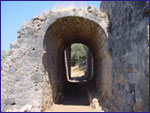 Some documents written towards the end of the Middle Ages name Gemiler Adasi as ‘St. Nicholas Island.’ Even today, there are some places where the island is referred to as St. Nicholas Island. Though this might be the case, St. Nicholas was born in Patara during the 4th century A.D. and was the archbishop of Myra, so we know he didn’t live on the island. However, there were more than ‘1,000 churches built in Anatolia and beyond that were named after this saint otherwise known as Santa Claus. Some documents written towards the end of the Middle Ages name Gemiler Adasi as ‘St. Nicholas Island.’ Even today, there are some places where the island is referred to as St. Nicholas Island. Though this might be the case, St. Nicholas was born in Patara during the 4th century A.D. and was the archbishop of Myra, so we know he didn’t live on the island. However, there were more than ‘1,000 churches built in Anatolia and beyond that were named after this saint otherwise known as Santa Claus.  The most magnificent church on Gemiler Adasi is Church No.111, which is located at the highest point on the island, 99 m. above sea level. Books written during the Middle Ages mention this church in the following way, “St. Nicholas Church is located at the top of the island.” This church is a basilica measuring 30 m. long with three passageways. The W portion of the church was made by cutting through the slope of a rock. It is presumed to have had a wooden roof covered with adobe tiles. Access to the entrance is through the mouth of the tunnel which connects this church to Church No.IV. The most magnificent church on Gemiler Adasi is Church No.111, which is located at the highest point on the island, 99 m. above sea level. Books written during the Middle Ages mention this church in the following way, “St. Nicholas Church is located at the top of the island.” This church is a basilica measuring 30 m. long with three passageways. The W portion of the church was made by cutting through the slope of a rock. It is presumed to have had a wooden roof covered with adobe tiles. Access to the entrance is through the mouth of the tunnel which connects this church to Church No.IV.
Ekincik
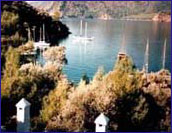 cape of Ekincik Koyu and surrounded by green pine woods. Just as you are able to anchor in several spots in the wide Ekincik Koyu, a bay called “My Marina” is also a secure anchorage. Here the local people have formed an pleasant motorboat taxi service that takes you from your yacht on up to Caunos. You can drop anchor in the part the motorboats are located, in front of the wide beach, or else you can even in the nearby bay just opposite the lighthouse. cape of Ekincik Koyu and surrounded by green pine woods. Just as you are able to anchor in several spots in the wide Ekincik Koyu, a bay called “My Marina” is also a secure anchorage. Here the local people have formed an pleasant motorboat taxi service that takes you from your yacht on up to Caunos. You can drop anchor in the part the motorboats are located, in front of the wide beach, or else you can even in the nearby bay just opposite the lighthouse. If by any chance you can find a place for you and your mates in this bay of blues and greens, anchoring here is going to be both secure and enjoyable. 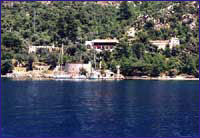 Those daily excursion motorboats out of Marmaris only go as far as Delik Adasi, where the Dalyan Stream flows into the sea. From here you’ll board another motorboat that takes you to Caunos along a very shallow channel that resembles a dreamworld. Those daily excursion motorboats out of Marmaris only go as far as Delik Adasi, where the Dalyan Stream flows into the sea. From here you’ll board another motorboat that takes you to Caunos along a very shallow channel that resembles a dreamworld.
The channel, which twists and winds its way all the way up to Köycegiz Gölü, takes on another meaning with magnificent scenery of the reedy marshes and Lycian rock tombs. After wandering around the Caunos ruins and visiting the curative mud baths, the romantic return to the sea is bound to remain etched in your memories for the rest of your lives. 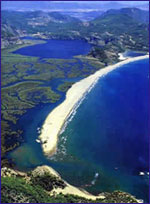 Dalyan / Caunos (optional trip to Dalyan - mud baths, turtlesand ruins of Caunos) Dalyan / Caunos (optional trip to Dalyan - mud baths, turtlesand ruins of Caunos)
Situated on the border of ancient Lycia and Caria, Caunos receives much attention today for the fact that it is very close to where the giant loggerhead turtle Caretta Caretta goes ashore to deposit its eggs, for its Lyciantype tombs, for its Venetian-like channel and most importantly for its ruins.
As the taxi boat winds its way through the channel up to Caunos, you will suddenly come face to face with several magnificent Lycian-type rock tombs. There are three stone beds inside the tombs in which the deceased were placed. From the fragments of earthenware uncovered, the tombs have been dated to the 4th century B.C. One of the three of four inscriptions that were found just above these tombs, contains two words related to the Carian language, while it is understood that the other tombs were recycled during the 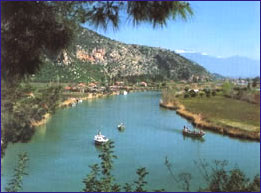 Roman Period. The facades of the tombs, which were carved out of the sheer rock have two columns of the Ionian order. On top of the columns, you’ll see exterior friezes above pediments which were decorated with acroters in three corners. Most of the columns are no longer intact. Of the pediments, all but one is plain, with a unique example of a relief of two lions positioned face-to-face. To the side of this incredible group of tombs is yet another tomb, which is plainer, and incomplete. On the W end of this group of tombs, which is near the village, are more Carian-type tombs which were not decorated like the others. In addition, there are niches that were opened on the lower rock surface for votive offerings. Roman Period. The facades of the tombs, which were carved out of the sheer rock have two columns of the Ionian order. On top of the columns, you’ll see exterior friezes above pediments which were decorated with acroters in three corners. Most of the columns are no longer intact. Of the pediments, all but one is plain, with a unique example of a relief of two lions positioned face-to-face. To the side of this incredible group of tombs is yet another tomb, which is plainer, and incomplete. On the W end of this group of tombs, which is near the village, are more Carian-type tombs which were not decorated like the others. In addition, there are niches that were opened on the lower rock surface for votive offerings. The name Dalyan’ means fishery, and a complicated system of barriers has been built among the reeds to allow the gray mullet and sea bass to be caught as they head for the sea. Let’s go ashore at the landing next to the fishery and wander around the ruins. The first thing we see is the acropolis of Caunos, which rises 152 m. high over a cliff in the S quadrant. The fortification walls situated in the N quadrant appear to be from the Middle Ages. 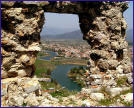 This trip will be absolutely your favorite because it offers you such variety. Experience beautiful scenery while cruisig through the Dalyan river marshes. Passing the famous Caunos rock tombs and ruins before arriving the mud baths. Here you have a chance to pamper yourself in the mud and sulphur pools and will feel the wrinkles dissaoearing! Now feeling cleansed and fresh you are ready for a riverside lunch stop and perhaps a beer or two! After lunch drift down the river again to relax, soak up the sun, swim and share the same beach space as the Caretta Caretta turtles who still breed here. This trip will be absolutely your favorite because it offers you such variety. Experience beautiful scenery while cruisig through the Dalyan river marshes. Passing the famous Caunos rock tombs and ruins before arriving the mud baths. Here you have a chance to pamper yourself in the mud and sulphur pools and will feel the wrinkles dissaoearing! Now feeling cleansed and fresh you are ready for a riverside lunch stop and perhaps a beer or two! After lunch drift down the river again to relax, soak up the sun, swim and share the same beach space as the Caretta Caretta turtles who still breed here.
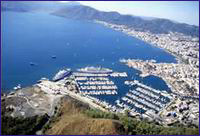 Marmaris Marmaris
As this quaint district, which is surrounded by green pine forests, was established directly over the ancient city of Phychos we do not have much information about the ancient site. However, from what we gather from a certain inscription, Phychos existed during the time of Alexander the Great, whereby the acropolis of this city was established one kilometer N of Marmaris on a low hill called Asartepe. Though it wasn’t long ago when there were visible remains of the ancient fortification wall, which was erected in the Classic and Hellenistic Periods, nothing can be seen of it today. After the death of Alexander, the Marmaris region was annexed to the Pergamon Kingdom, then it was captured by the Romans, Byzantines, the Mentese Beylik and then the Ottomans, respectively.
Among the few historical buildings found in Marmaris today, are a castle, which was built in 1557 and recently restored, a mosque in Kemeralti District, which was built by Mengelizade Ibrahim Aga in 1789 as well as a caravanserai which was constructed in 1545. This stone inn with brick vaults was erected on the road to Mugla during the reign of Süleyman the Magnificent in the military campaign against Rhodes. Located near the old junior high school is the Degirmen Brook Bridge, which was also erected during the time of Süleyman the Magnificent. If you have the time, we recommend that you check out Sedir Adasi, as well as 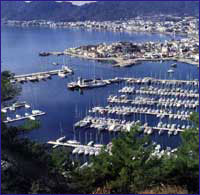 Karacasögüt, where you can see ancient theaters, temples and fortification walls. As you come out the bay, your boat will manuever past Keci Adasi and Yildiz Adasi, otherwise known as Nimara to call on Alkaya Cave. Then you will sail out to Kumlubük where to take a break of a couple of hours for lunch and an afternoon swim in the sea. Straight up from the pier are the Amos Ruins, which are situated on Asartepe. Karacasögüt, where you can see ancient theaters, temples and fortification walls. As you come out the bay, your boat will manuever past Keci Adasi and Yildiz Adasi, otherwise known as Nimara to call on Alkaya Cave. Then you will sail out to Kumlubük where to take a break of a couple of hours for lunch and an afternoon swim in the sea. Straight up from the pier are the Amos Ruins, which are situated on Asartepe. With its styrax forest in the middle of the city, excursion trips taken with motorboats and its natural beauty, Marmaris is an ideal spot for rest and relaxation. In addition, the town, which is complimented with wonderful nearby bays such as Sedir Adasi, Karacasögüt, Mersincik, Hisarönü, is a paradise on earth. 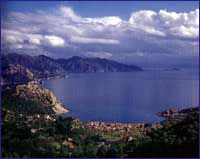 Turunc Bükü Turunc Bükü
The closest bay to Marmaris is that of Turunc Bükü, situated at a distance of two nautical miles outside Kumlu Bükü. Because of the cape situated in front, Turunc Bükü is regarded as a safe haven from prevailing winds. One can navigate into the bay by sailing between the island of Kargatasi and the mainland. There is a reef off the shore of the mainland, about half a nautical mile NW of this island.
Kumlu Bükü
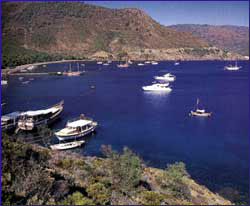 Kumlu Bükü is a bay comprised mostly of sandy beach, hence the name ‘Kumlu Bükü.’ This beautiful wide bay, which is surrounded by tree covered mountains is one of the few bays with a freshwater spring. However, the bay is exposed to the N, and is affected by reverse winds. Winds blowing from the SE stir up rough waves in the bay. Nevertheless, this is one of the most ideal bays to drop anchor whenever there aren’t any strong winds gusting. Several mooring spots are found in Kumlu Bükü, which is very close to Marmaris. For instance, there is a small cove at the SE point of the bay that is striking for its crystal clear water. Shaded by pine trees, this cove is convenient for mooring in that you can drop anchor in 4 - 5 m. of water and tie a line to shore. Here, you will find the freshwater spring here as well as there are a few motels and restaurants located in the bay. One can take advantage of their services by mooring up alongside the piers. Daily excursion tour boats stop here for meal breaks, whereas sunseekers can catch some rays on the wide beach and take a dip in the sea to cool off. Kumlu Bükü is a bay comprised mostly of sandy beach, hence the name ‘Kumlu Bükü.’ This beautiful wide bay, which is surrounded by tree covered mountains is one of the few bays with a freshwater spring. However, the bay is exposed to the N, and is affected by reverse winds. Winds blowing from the SE stir up rough waves in the bay. Nevertheless, this is one of the most ideal bays to drop anchor whenever there aren’t any strong winds gusting. Several mooring spots are found in Kumlu Bükü, which is very close to Marmaris. For instance, there is a small cove at the SE point of the bay that is striking for its crystal clear water. Shaded by pine trees, this cove is convenient for mooring in that you can drop anchor in 4 - 5 m. of water and tie a line to shore. Here, you will find the freshwater spring here as well as there are a few motels and restaurants located in the bay. One can take advantage of their services by mooring up alongside the piers. Daily excursion tour boats stop here for meal breaks, whereas sunseekers can catch some rays on the wide beach and take a dip in the sea to cool off. The ruins of an ancient city called Amos are situated on top of Kumlu Bükü’s N cape. You can trek up the hill to check out these ruins from the point where the beach ends. Here, you will see a fortification wall measuring 1.83 m. thick and 3-3.5 m. high. The N side of this wall, which was constructed in the Cyclopean style, was reinforced with numerous ramparts. You can see that its gate was on this side. This wall along with all the other edifices in Amos date to the Hellenistic Period.  Kadirga Burnu Kadirga Burnu
Kadirga Burnu, where a lighthouse and a cottage for the lighthouse operators are situated. Kadirga Limani is right behind the cape. This is also known as ‘Çayagiz Koyu.’ There are submerged rocks in front of Kadirga Limani’s other cape. There are two inlets in the wide bay between the two capes. You can pitch your anchor overboard in the S inlet to a depth of 6 m. and tie your yacht to the shore. This location is closed off from all winds and exposed to the NW and B. You can navigate between the mainland and an island situated in front of the N cape of the bay. This is an ideal spot for those who like to swim.
Ciftlik
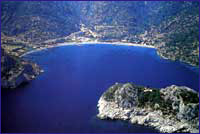 Çiftlik Limani is located one nautical mile NE of Ince Burun, whereas Çiftlik Adasi is situated in front of this beautiful bay with its wide beach. This island facilitates relative protection for the bay from prevailing NW and SE winds. There is a holiday village at the B end of this round bay, whereas hotels and restaurants are found in the middle. The concrete pier in front of the holiday village belongs to the hotel. There are steel piers in front of the restaurants in the bay. You can secure your yacht along one of the piers in this beautiful bay and dine in one of the restaurants here. Çiftlik Limani is located one nautical mile NE of Ince Burun, whereas Çiftlik Adasi is situated in front of this beautiful bay with its wide beach. This island facilitates relative protection for the bay from prevailing NW and SE winds. There is a holiday village at the B end of this round bay, whereas hotels and restaurants are found in the middle. The concrete pier in front of the holiday village belongs to the hotel. There are steel piers in front of the restaurants in the bay. You can secure your yacht along one of the piers in this beautiful bay and dine in one of the restaurants here. 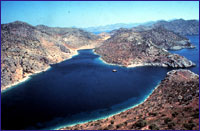 Serce Limani Serce Limani
Ancient mariners knew that Serçe Limani was a sheltered harbor that they often took refuge during stormy weather. Here there are a total of six shipwrecks found in the vicinity; four inside the bay and two outside the bay. One of these occurred in the year 1025. The captain piloting a Fatimid-flagged cargo vessel that had set out on its fateful journey from the Syrian coast bound for Constantinople. In addition to other cargo, its manifest indicated she was loaded with up to three tons of processed and raw glass that was to be processed in a small workshop located on the shores of the Bosphorus.
Weeks had gone by since the vessel had departed Syrian waters, and it sailed all the way to Bozukkale without any difficulty. After porting here for a while, she set sail, but it wasn’t long before she was caught in a terrible storm. To escape the maelstrom, the ships captain tried to duck into Serçe Limani, but unfortunately his vessel struck the rocks and was
damaged. He did manage to navigate her into the harbor, but she began taking on water and it wasn’t long before the vessel sank to the bottom of the sea with its precious load. It was almost a full millennium before this 16 m. vessel was brought back to the surface, when Prof. George Bass, along with a team of Turkish and American underwater archaeologists, accomplished this task in 1979. Today, the ship along with all its contents is on display at the Bodrum Museum of Underwater Archaeology.
The ancient town of Kasara is located above Serce Limani, which most likely was the harbor of this ancient town. Kasara means “the Big Village of the Mother Goddess.” Other than a few wall remnants, nothing else remains of this ancient town. Bozukkale
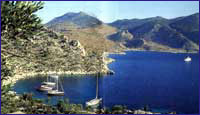 Bozukkale Harbor maintained its importance throughout the Byzantine Period as a Byzantine naval base and armory, whereas warship maintenance was carried out in this shipyard. Bozukkale Harbor maintained its importance throughout the Byzantine Period as a Byzantine naval base and armory, whereas warship maintenance was carried out in this shipyard. After anchoring in this historical bay, let’s climb up to see the castle situated at the end of the cape. Measuring 27.4 m. wide by 320 m. long, and surrounded by fortification walls 2.44 in. in thickness, this long, narrow castle was erected to protect the bay. There were once nine square-shaped ramparts along protective walls made from straight cut stones. However of the original nine, only a single promontory rampart in the N can be seen today. There are round towers situated at the two ends of the castle. Immediately in front of these towers are cisterns which were carved partly from the rock. Four of the five gates of the fortification wall are situated in the section facing N. The ancient city of Loryma is situated on the hill to the B of the bay. If you have the time and are interested in history, it will take you about an hour to hike up the hill, whereby you can wander around this ancient city. You will find it is a nice way to regain your landlubber legs after spending so much time at sea 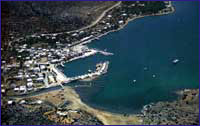 Bozburun Bozburun
As Bozburun Harbor was established right at the foot of a rocky mountain, it is sealed off from all prevailing winds. Bozburun, which is the nearest inhabited place to Rhodes and Simi Island is famous for its boat construction. There are 25 shipyards here that are involved in the business of constructing wooden vessels.
The historical artifacts found on the islands situated in front of Bozburun imply that it was inhabited during ancient times. In the NE quadrant of Bozburun, there lies the ancient city of Larymna, which the local people call the Castle. The city’s acropolis is found on a hill called Asartepe. The old city’s necropolis is located on the slope of the hill, which can be reached by climbing up from the vicinity of the Bozburun Pier. Here, you can encounter ruins of a fortification wall and its rectangular-shaped battlements. The ancient city of Tymnos, which until recently was thought to be in Bozburun, is actually further E in Sögüt One can find a post office, gendarmes station and village health clinic in Bozburun where you can also dine in the restaurants and purchase provisions in the markets. Bencik
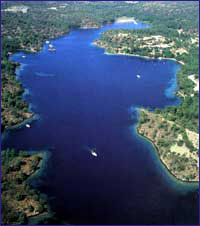 Bencik Koyu is a bay possessing extraordinary beauty. it extends inland up to 1.5 nautical miles through Bencik Koyu with its serrated rocks resembling human teeth. Bencik. which is the narrowest spot on Datça Peninsula, divides the Marmaris and Datça districts from each other. The inner reachs of the fjord are shallow and marshy, whereas its other parts are clean and sparkling blue. Bencik Koyu is a bay possessing extraordinary beauty. it extends inland up to 1.5 nautical miles through Bencik Koyu with its serrated rocks resembling human teeth. Bencik. which is the narrowest spot on Datça Peninsula, divides the Marmaris and Datça districts from each other. The inner reachs of the fjord are shallow and marshy, whereas its other parts are clean and sparkling blue. 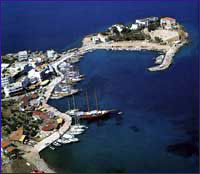 Datça Datça
Datca, from which the peninsula derives its name, is a coastal district that possesses a jetty offering shelter from the wind. The jetty is on a peninsula that stretches towards the E, four nautical miles to the N of Ince Boron, which is marked on the chart with a lighthouse. This peninsula divides two bays, one to the N and the other to the 5, whereas the one to the S is protected by a breakwater which is positioned in the sea in a SE direction. There is a half-salt, half-freshwater lake adjacent to the dis
» »
»Search by name
»Search by length
»Search by Guest
»
Copyright 2007-2025 CharterIndexTurkey.com
Copyright 2007-2025 CharterIndexTurkey.com
| 